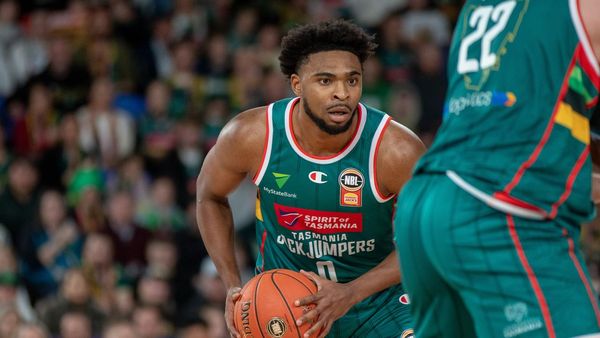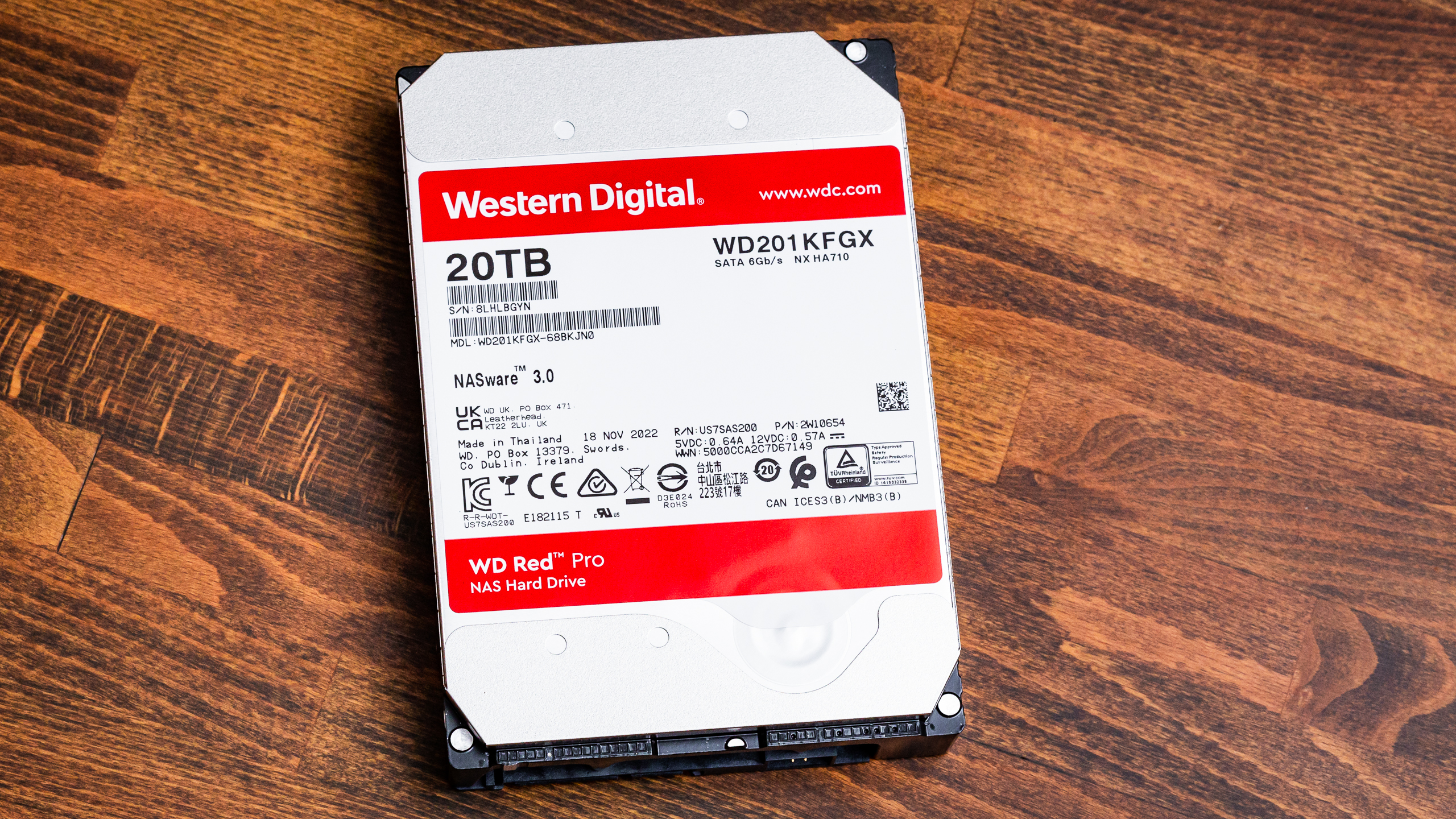
The 20TB Red Pro comes from WD’s NAS line of hard drives, utilizing their unique OptiNAND technology. This technique marries mechanical and flash storage technologies to achieve higher capacity with a form of conventional magnetic recording (CMR) that's much faster than competing Shingled Magnetic Recording (SMR) drives. There is still a premium to be paid for this much space in a single device, and the performance is very predictable. The warranty is nothing to write home about, but if you need lots of storage for sequential transfers, the Red Pro will get the job done.
WD uses nine platters at 2.2TB each for the 20TB model, with extra capacity made possible by storing the necessary metadata on the onboard flash. WD’s vision is to use energy-assisted perpendicular recording (ePMR) to keep the benefits of CMR technology while offering unique benefits with OptiNAND. Many of the new features are only on the 22TB WD Gold so far, and while leveraging flash is a net benefit for WD, there is added complexity versus Seagate’s solution.
Specifications
The WD Red Pro is available between 2TB and 22TB in 2TB intervals, but we're looking specifically at the 20TB model today. Current low pricing at the time of review is $329.99 or $16.50 per TB, which is not unusual for the highest-capacity drives, on par with the 22TB IronWolf Pro at $362.99. It is currently cheaper than the Seagate Exos X20 and IronWolf Pro 20TB. The drive runs at 7200 RPM with a sustained transfer rate of up to 272 MBps. The cache is 512MB on this model, double the base model IronWolf Pro 20TB and Exos X20, but it has less cache at 12TB and below.
WD rates the average read/write power draw at 6.9W while producing an average of 32 A-weighted decibels of sound. This is relatively quieter than lower capacities, but it does pull more power. WD warranties the Red Pro lineup for five years with a workload rate of 300TB per year, meaning you can write 300TB of data per year to the drive and a mean time before failures of 1 million hours. This is less than the 1.2 to 2.5 million hours of the competition. Like the IronWolf Pro and Exos X20, the Red Pro uses CMR, not the slower shingled magnetic recording(SMR) technology.
The Seagate Skyhawk AI 20TB is intended for different workloads than these other drives and also costs more. However, it also has the full 2.5 million hours for MTBF rating and a workload rate limit of 550TB per year. It’s included in our testing for comparison purposes.
Software and Accessories
WD provides downloads on its website, including the Western Digital Dashboard and Acronis True Image for Western Digital applications. The Dashboard provides basic functionality such as providing drive information, SMART attribute monitoring, firmware updates, and more. The OEM Acronis True Image allows you to back up your OS or other files or clone your drives. The Red Pro lacks the three-year Rescue Data Recovery Services included with the IronWolf Pro.
A Closer Look
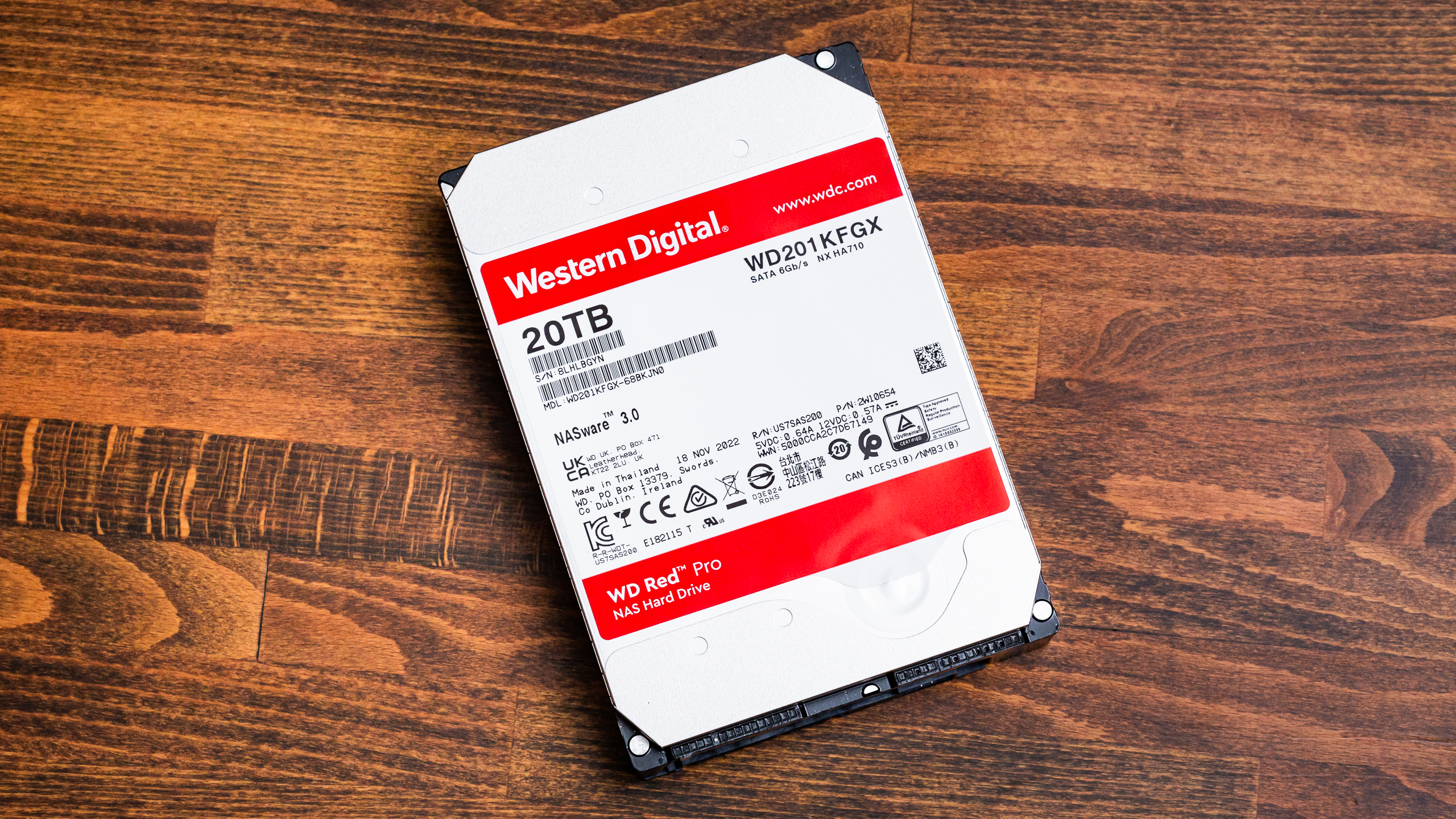

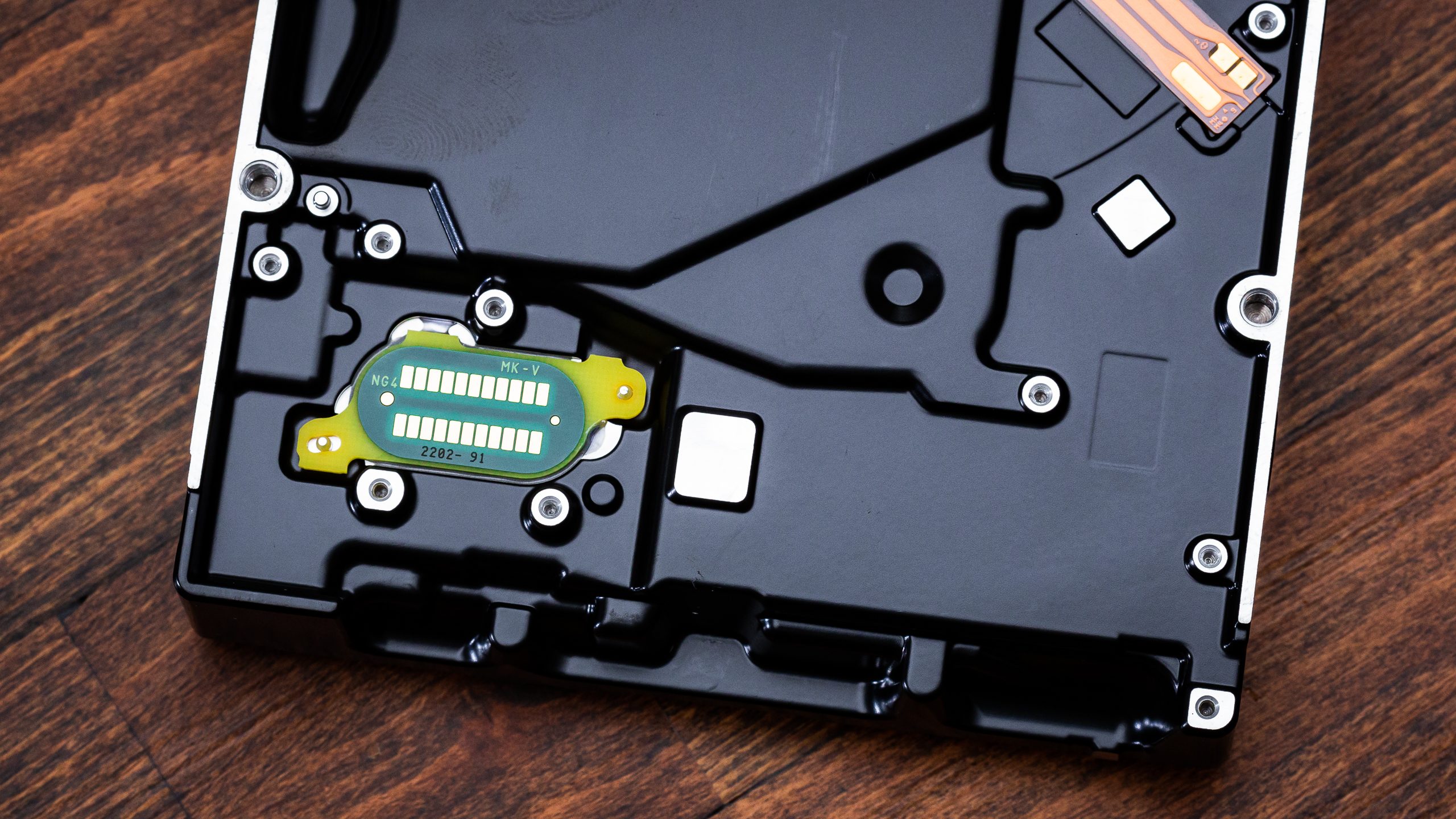
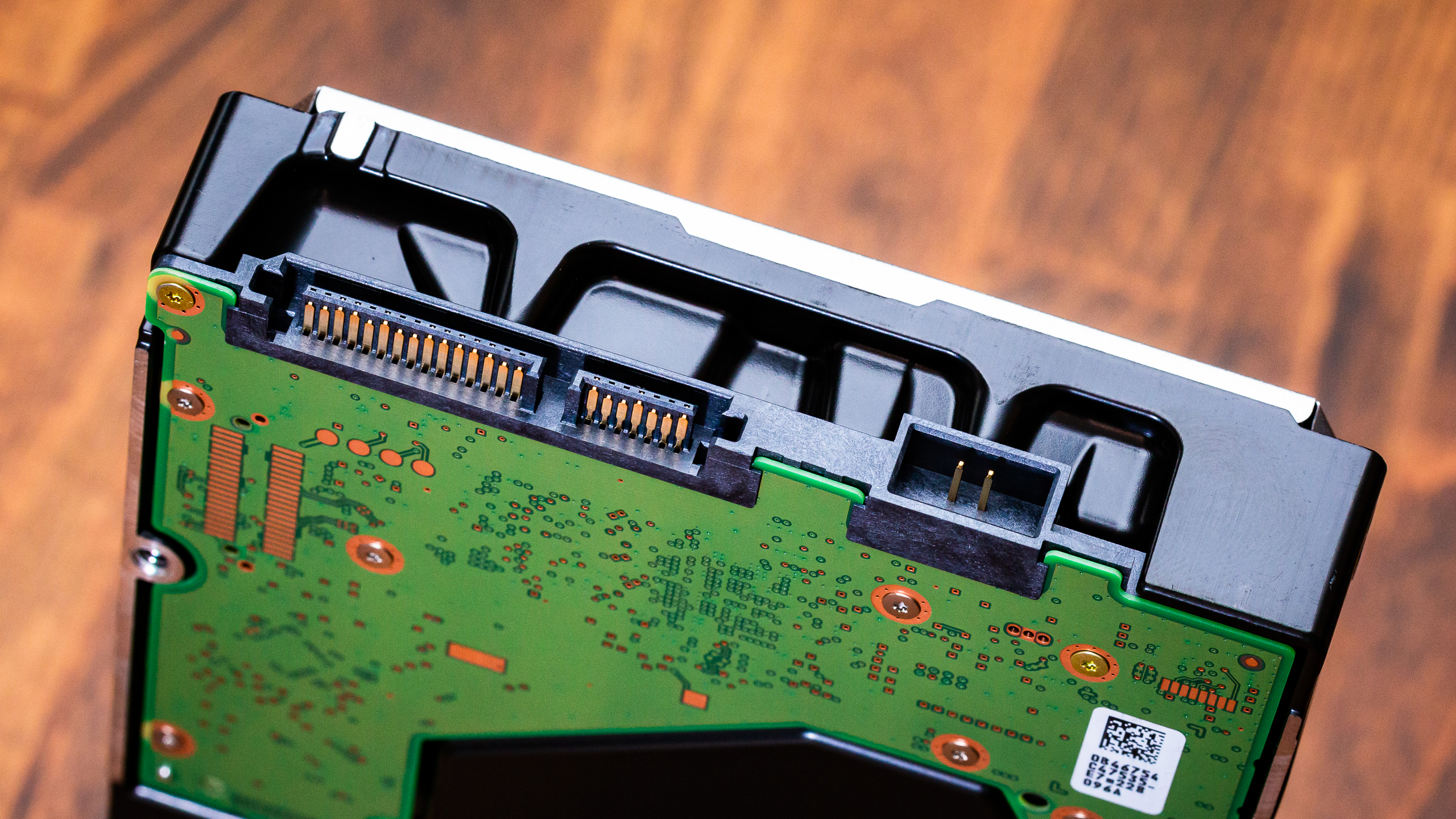
The Red Pro is not unusual in appearance, although the label does list that it has NASware 3.0. This firmware technology is optimized for usage in NAS systems and enclosures, essentially acting to balance various characteristics for the optimal combination of performance and reliability. Although this is essentially marketing, it is still true that hard drives need to be designed for a 24/7 environment while accounting for noise and vibration from the presence of multiple drives in a limited space.
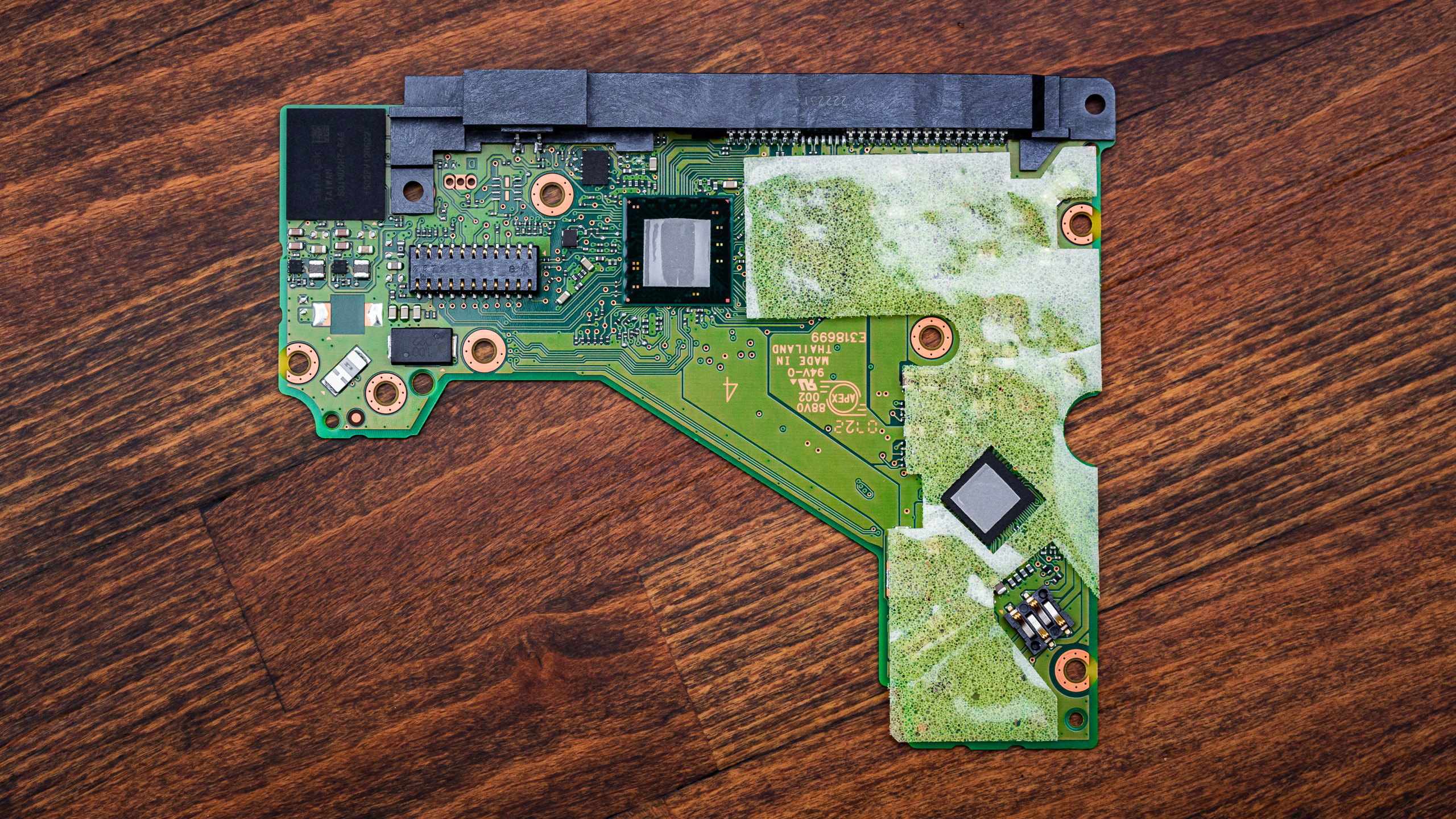

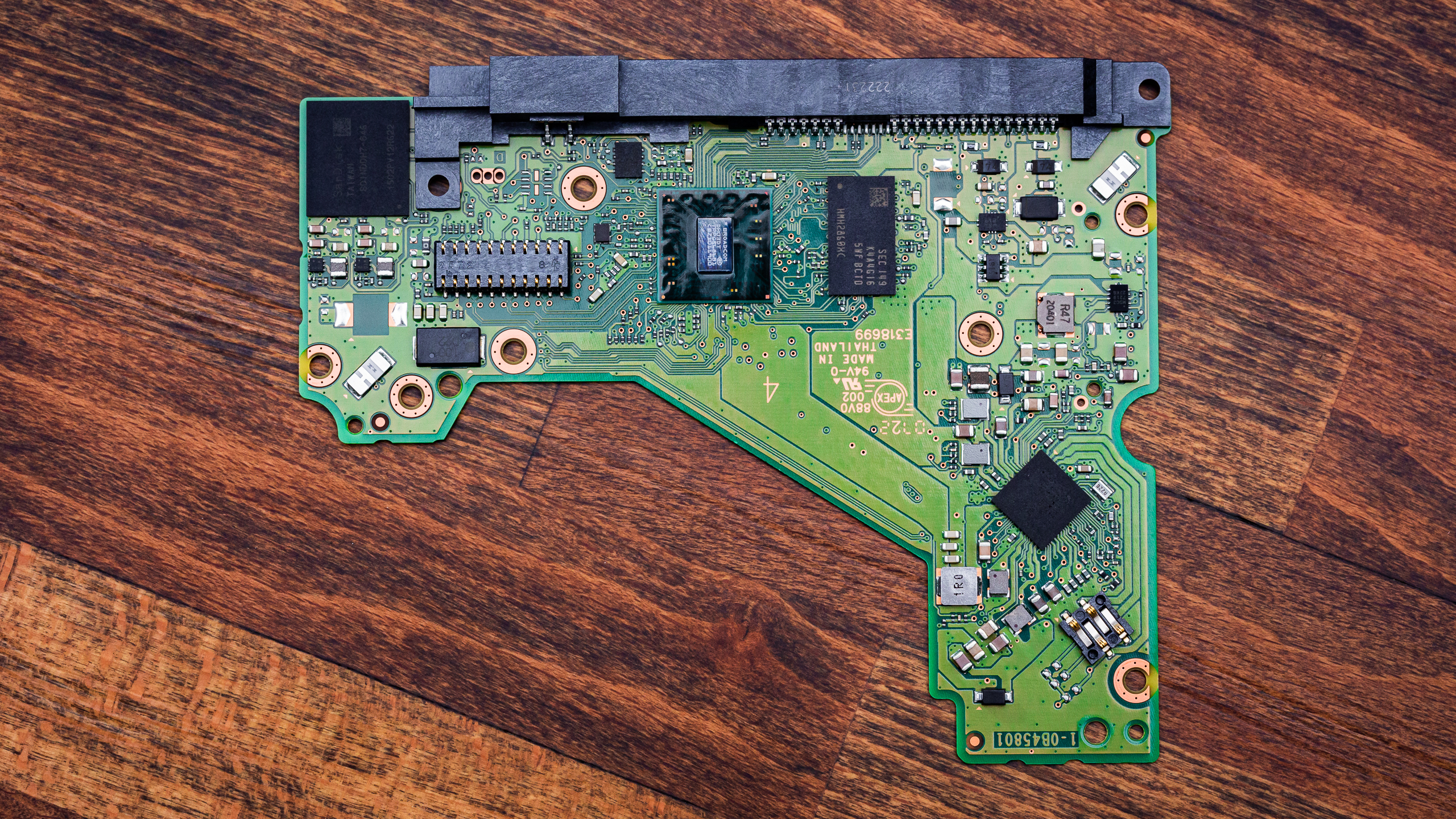
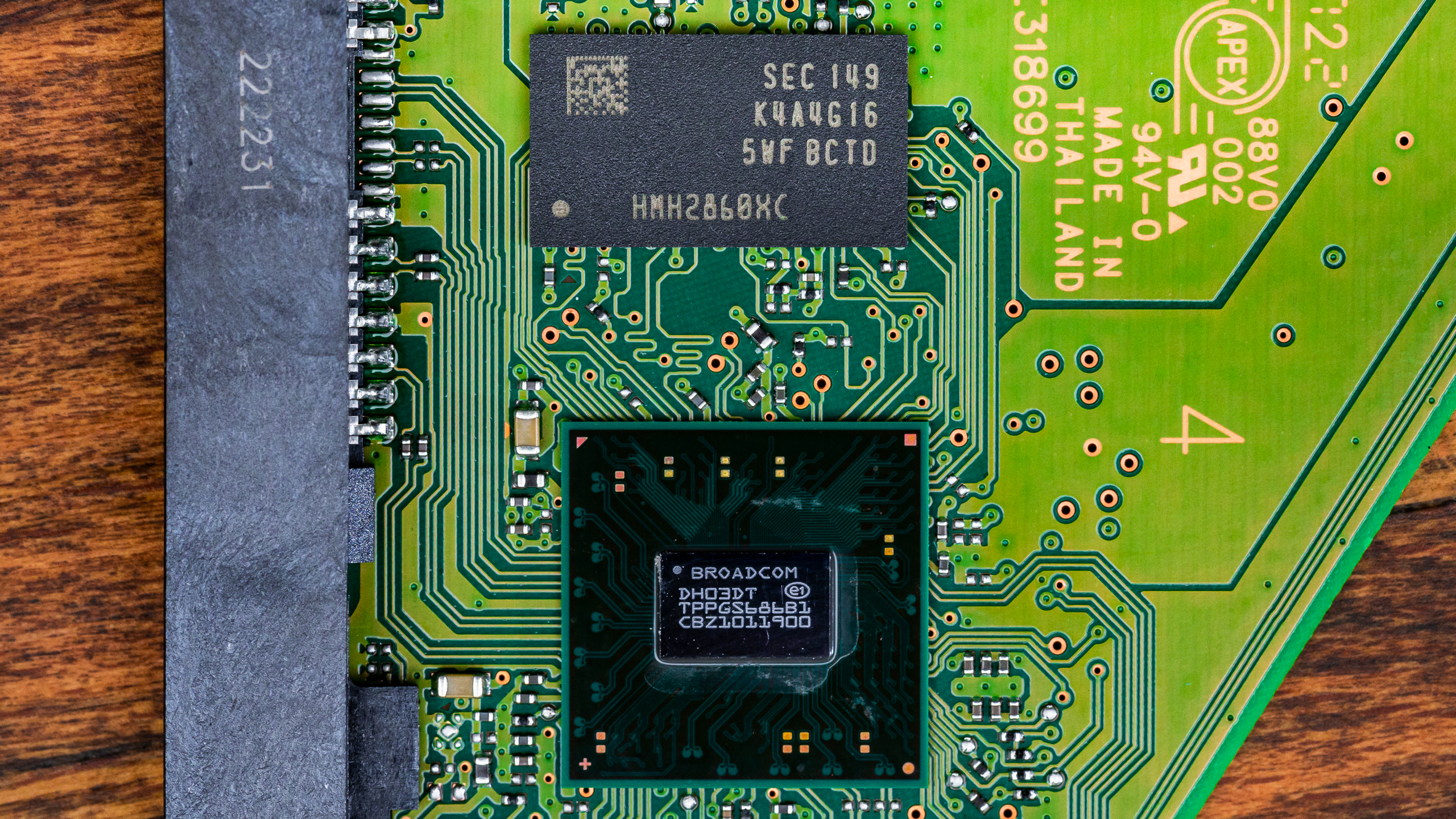
The drive has a Broadcom main controller, a spindle controller, and 4Gb or 512MB of DDR4 for its DRAM write cache. The controller system on a chip (SoC) has to be designed to work with flash for OptiNAND functionality. The cache is a step up over the 256MB found on some competing drives, possibly a benefit of cost savings realized by OptiNAND.
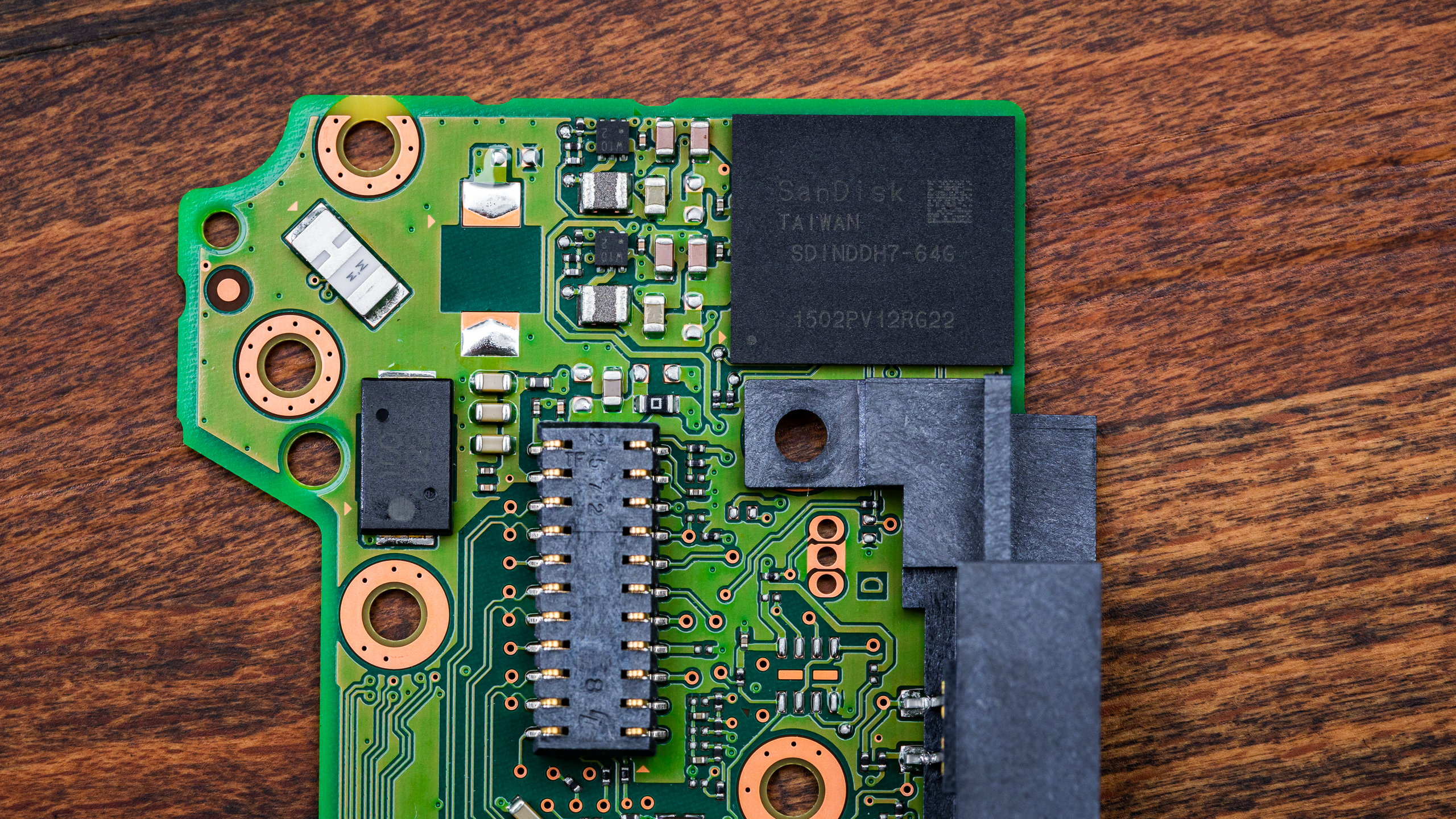
On-board is also 64GB of SanDisk-labeled, 64-Layer BiCS3 NAND flash. This is actually iNAND, or industrial NAND, designed for embedded environments, integrated as a Universal Flash Storage (UFS) Embedded Flash Drive (EFD). Such flash can operate in pSLC and TLC modes depending on the workload. Write workloads benefit from pSLC, while TLC is more effective for read workloads.
This implementation is not the same as a solid state hybrid drive (SSHD), but rather the flash is used to improve performance and capacity, primarily by handling drive metadata. WD’s current approach to high-capacity drives is potentially cheaper, and OptiNAND allows for some nice features, such as ArmorCache for emergency power-off (EPO) scenarios. However, other approaches that are used to get extra capacity will have different trade-offs as it is less complex to forgo the use of flash.
MORE: Best SSDs
MORE: Best External SSDs and Hard Drives
MORE: How We Test HDDs And SSDs
MORE: All SSD Content
Comparison Products
We are comparing the WD Red Pro to three other 20TB drives, including the Seagate Skyhawk AI and the Seagate Exos X20, and IronWolf Pro. Older models include the WD Black 6TB and the Seagate IronWolf Pro 8TB.
Trace Testing - 3DMark Storage Benchmark
Built for gamers, 3DMark’s Storage Benchmark focuses on real-world gaming performance. Each round in this benchmark stresses storage based on gaming activities including loading games, saving progress, installing game files, and recording gameplay video streams.
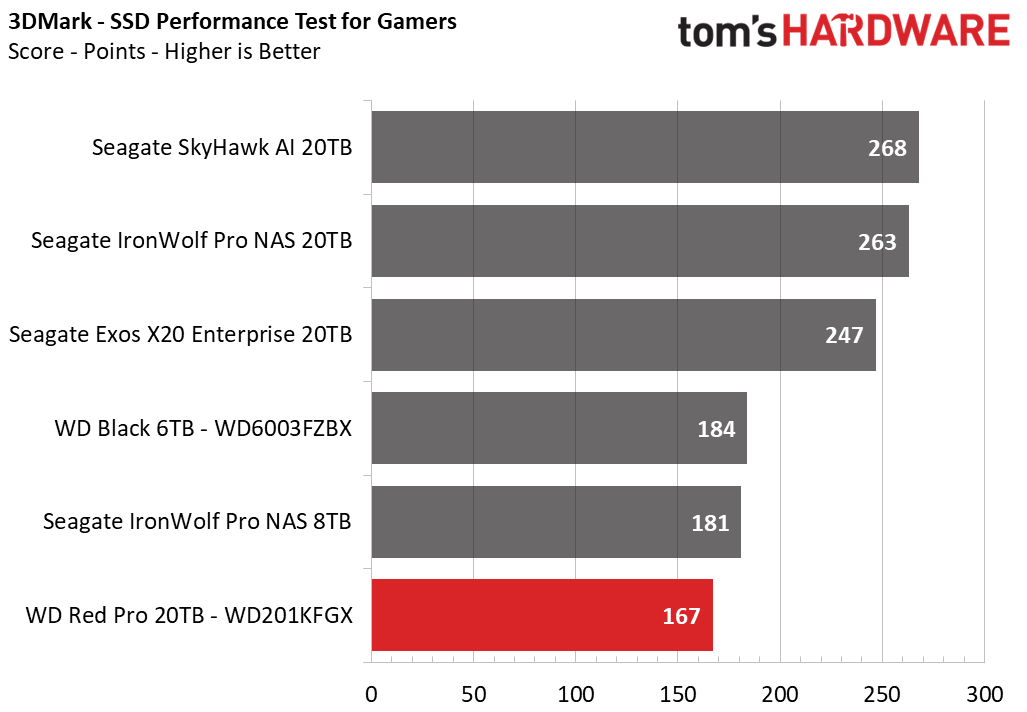
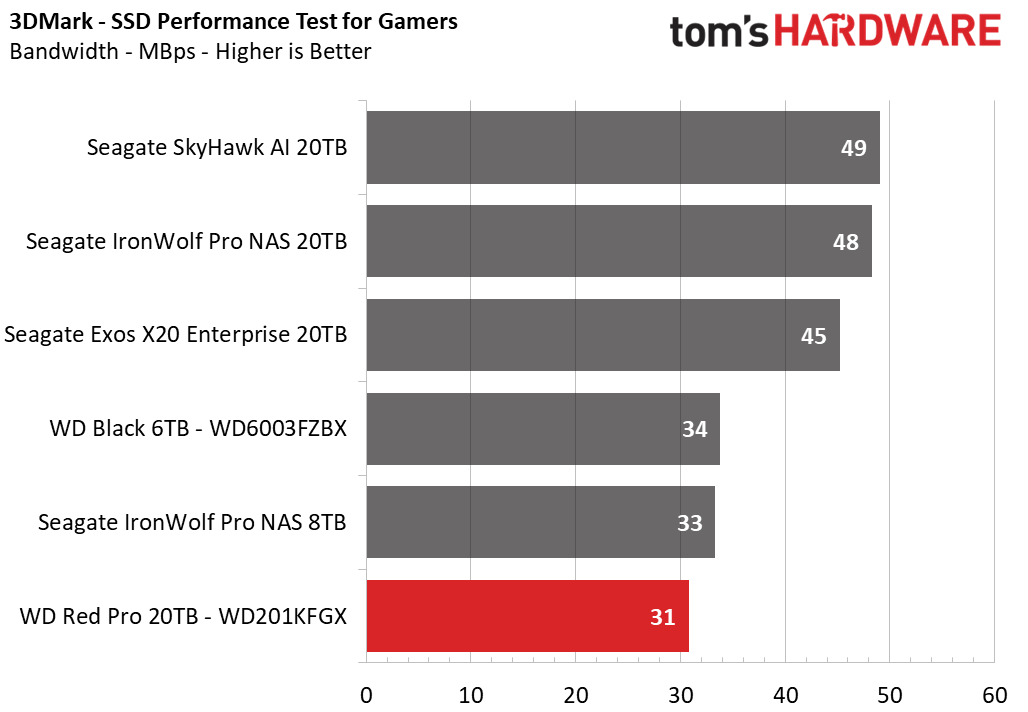
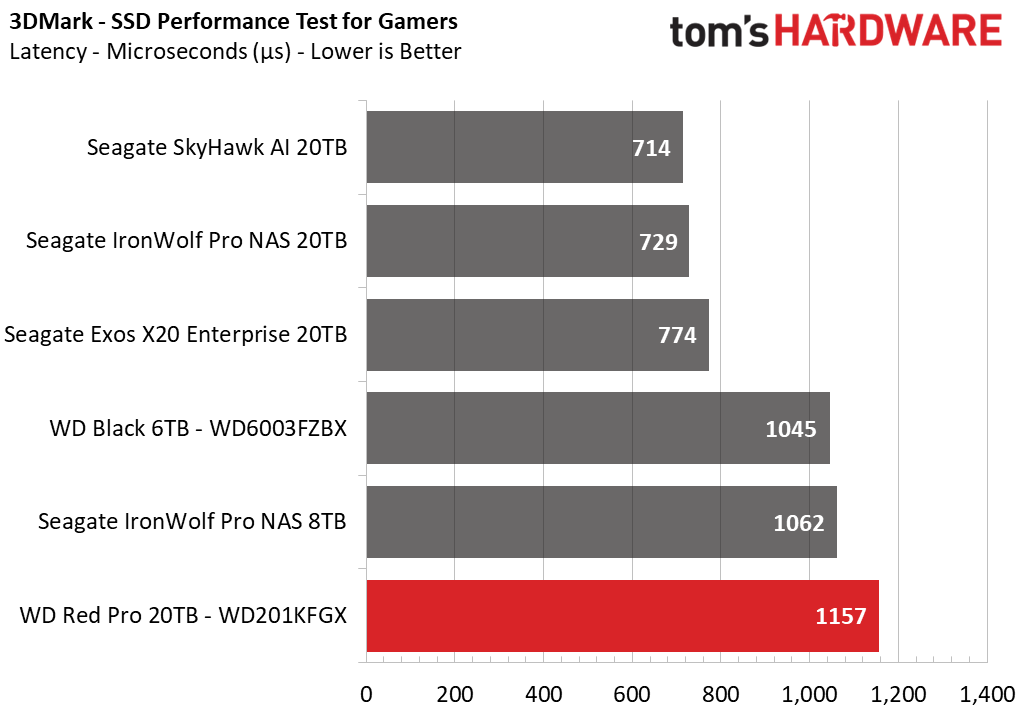
You should be gaming on an SSD by now, but 3DMark still shows us that the Red Pro falls short in comparison to the competition.
Trace Testing – PCMark 10 Storage Benchmark
PCMark 10 is a trace-based benchmark that uses a wide-ranging set of real-world traces from popular applications and everyday tasks to measure the performance of storage devices.
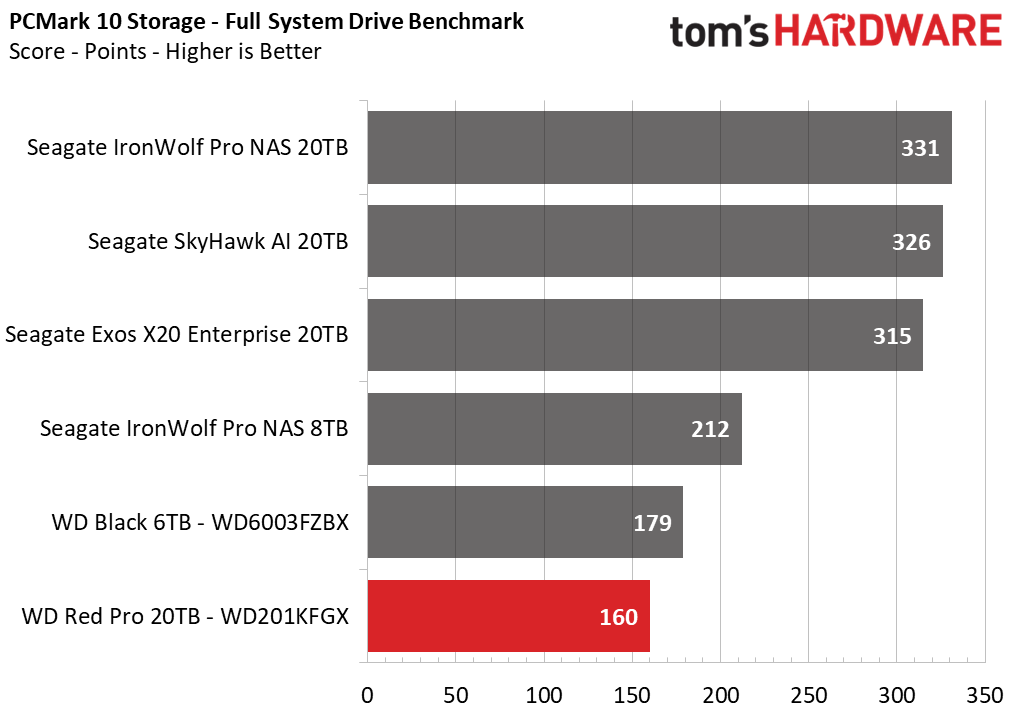
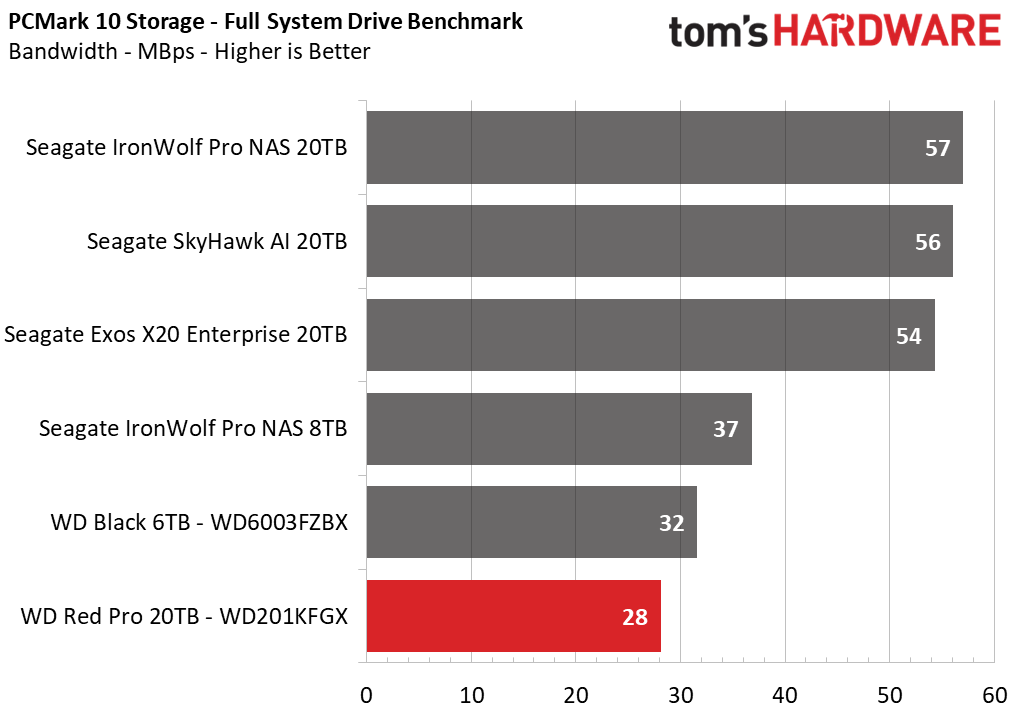
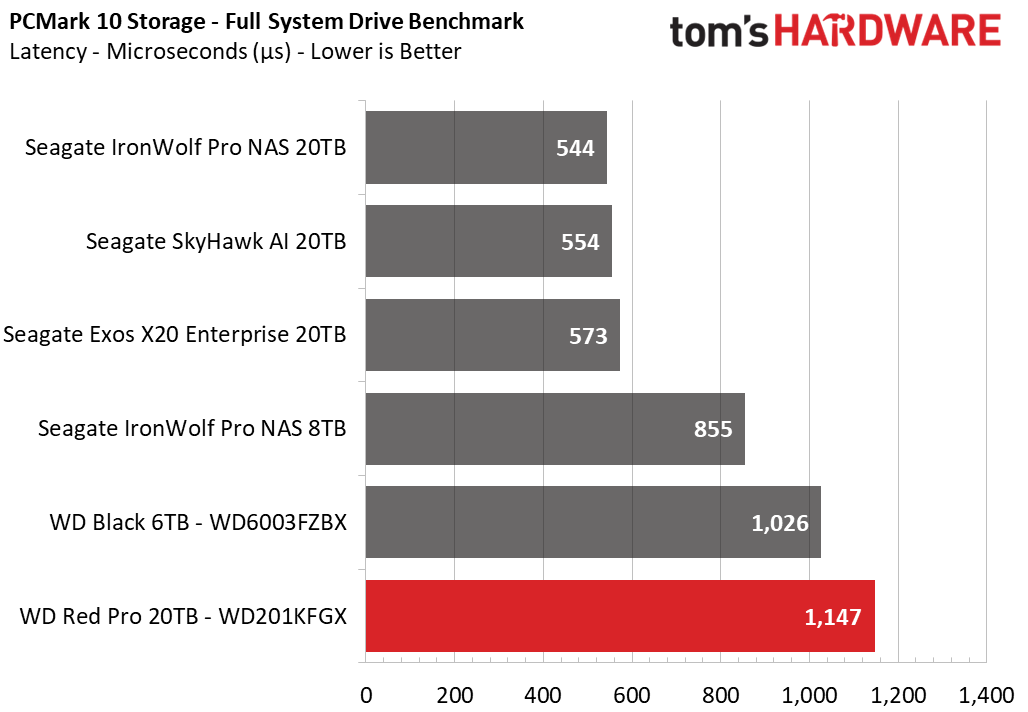
It’s common for drives to perform similarly in PCMark 10 and 3DMark, and that is the case here - the Red Pro is dead last again.
Transfer Rates – DiskBench
We use the DiskBench storage benchmarking tool to test file transfer performance with a custom, 50GB dataset. We copy 31,227 files of various types, such as pictures, PDFs, and videos to a new folder and then follow-up with a reading test of a newly-written 6.5GB zip file.
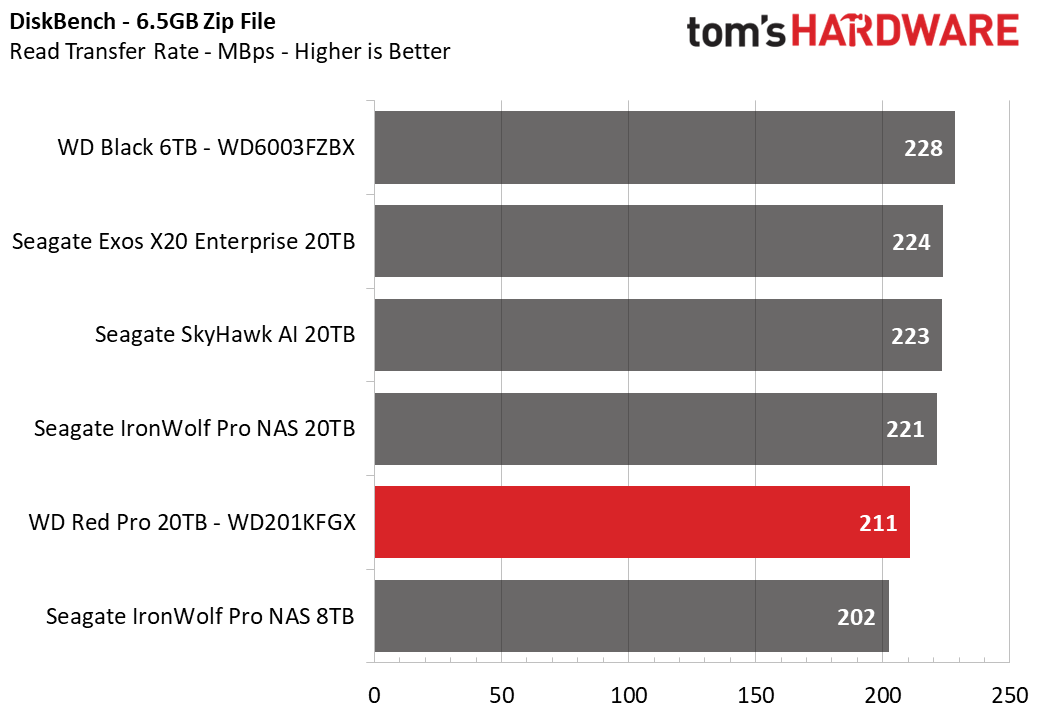

DiskBench is a more valid test for HDDs than SSDs, and we see that modern HDDs perform roughly the same in transfer rate.
Synthetic Testing - ATTO / CrystalDiskMark
ATTO and CrystalDiskMark (CDM) are free and easy-to-use storage benchmarking tools that storage vendors commonly use to assign performance specifications to their products. Both of these tools give us insight into how each device handles different file sizes.
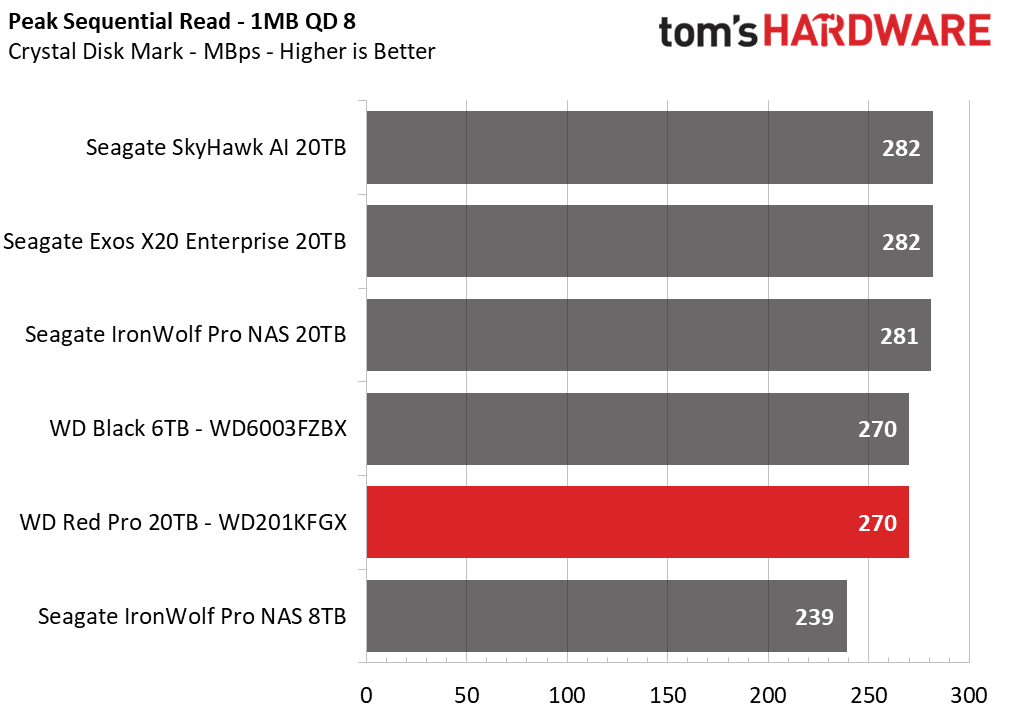
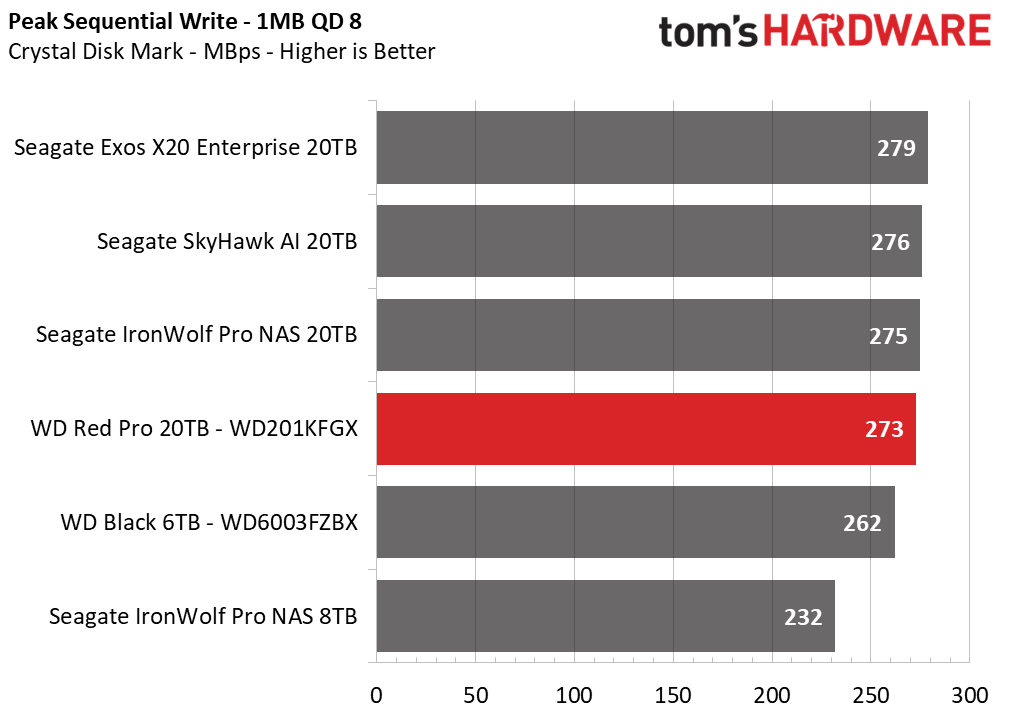
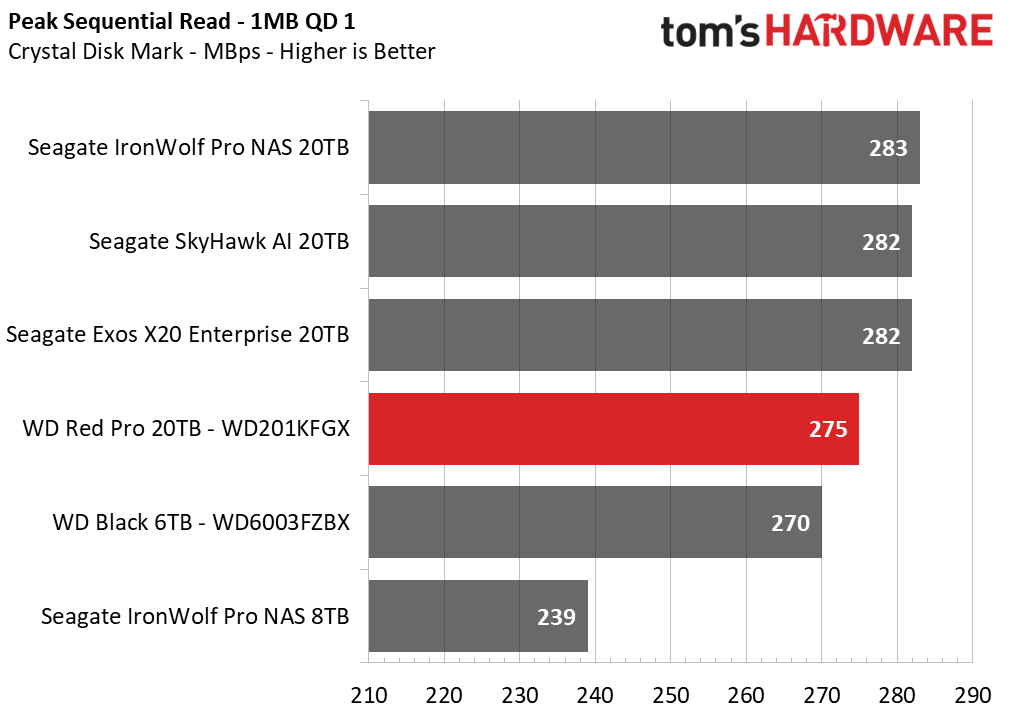
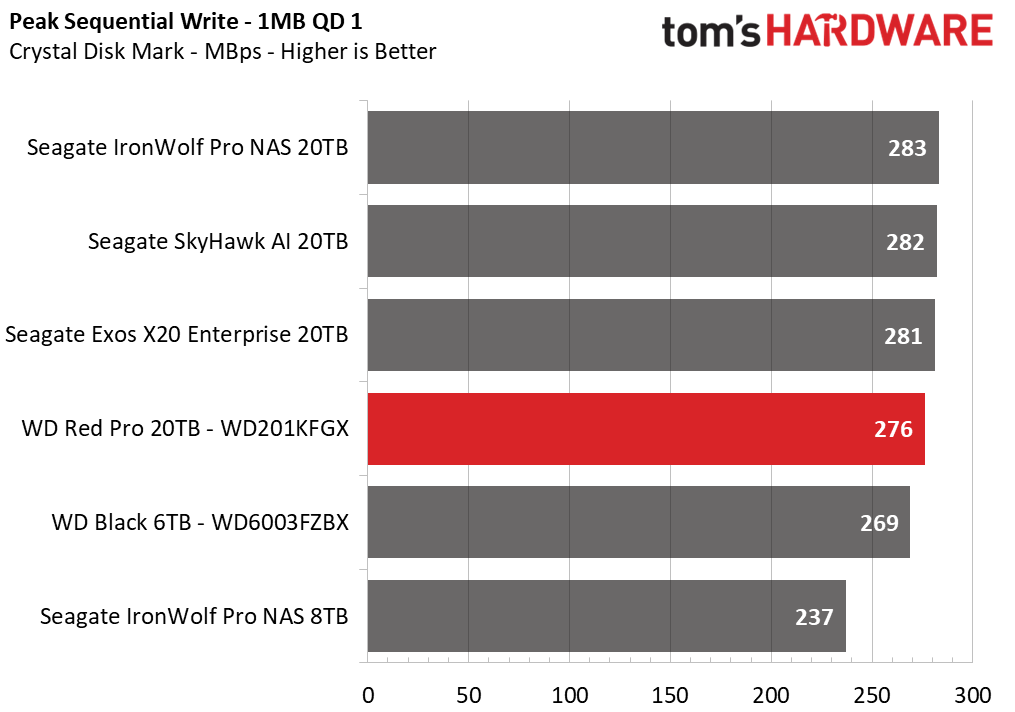
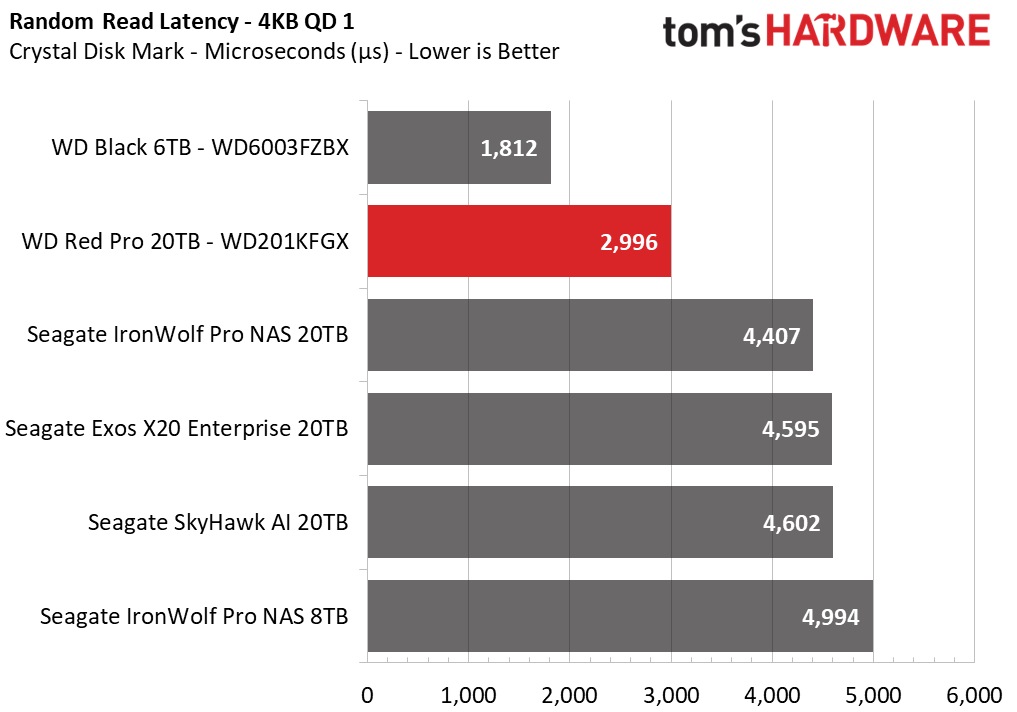
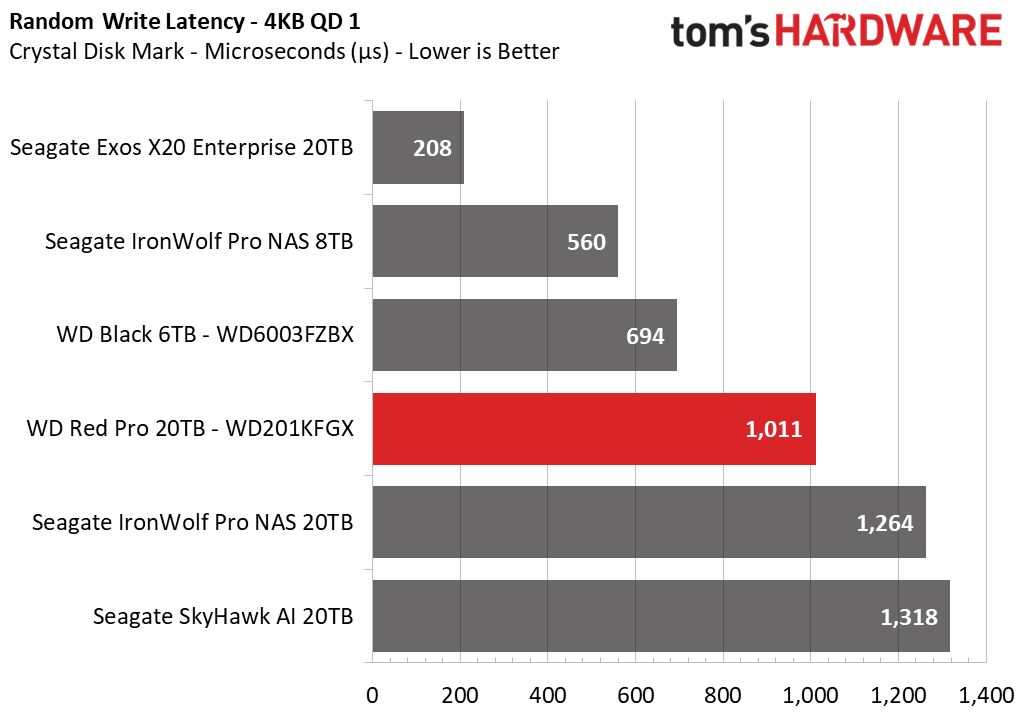
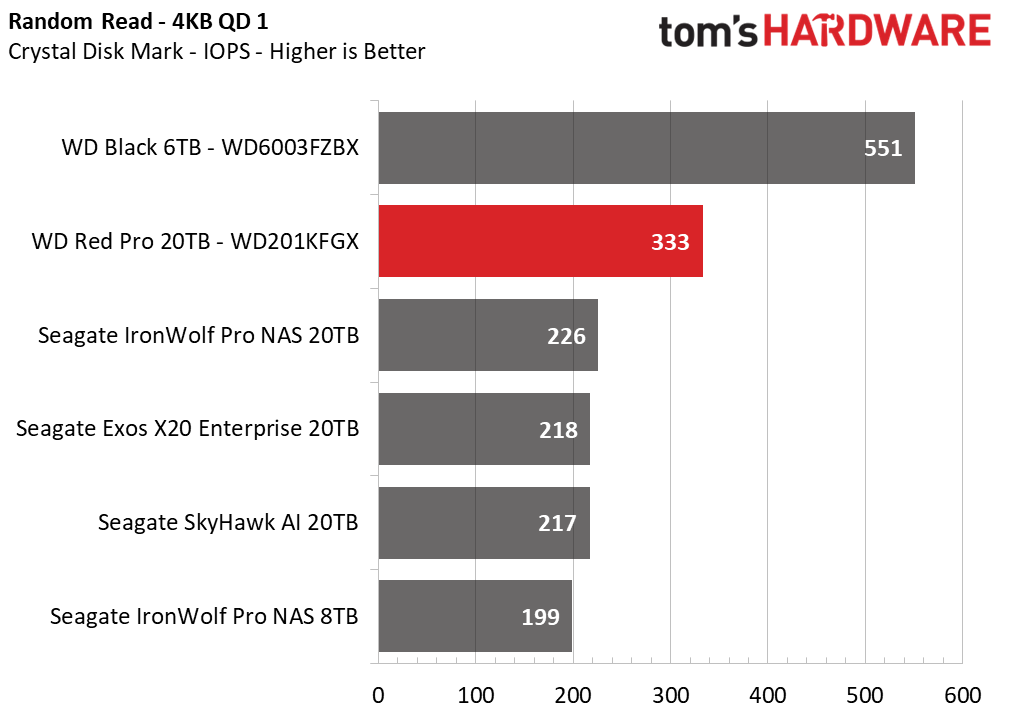
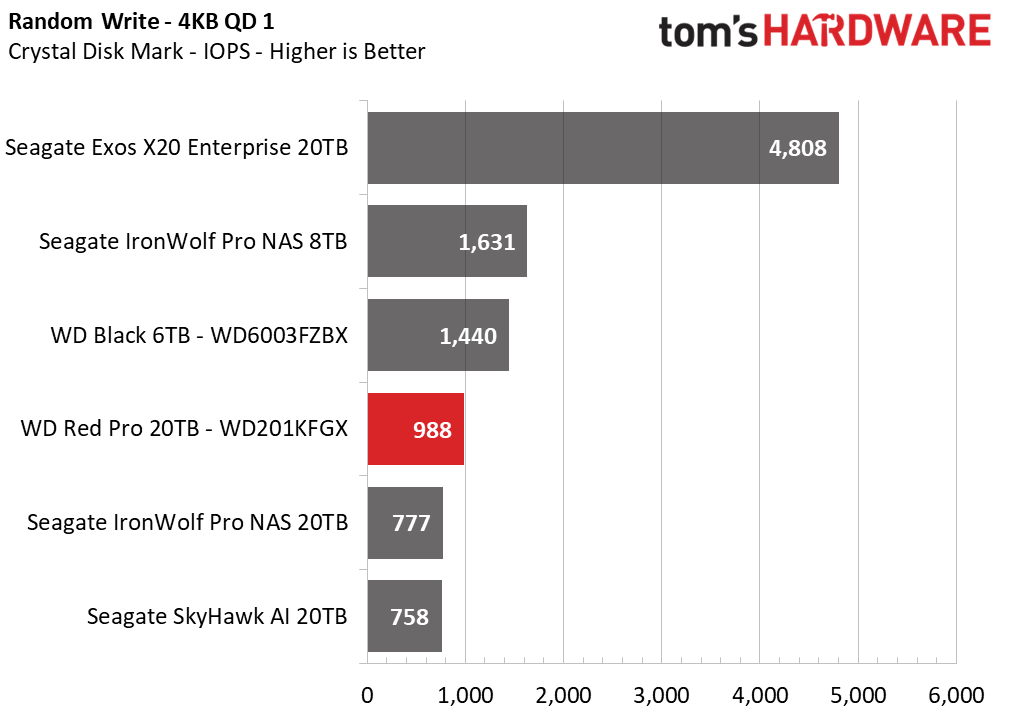
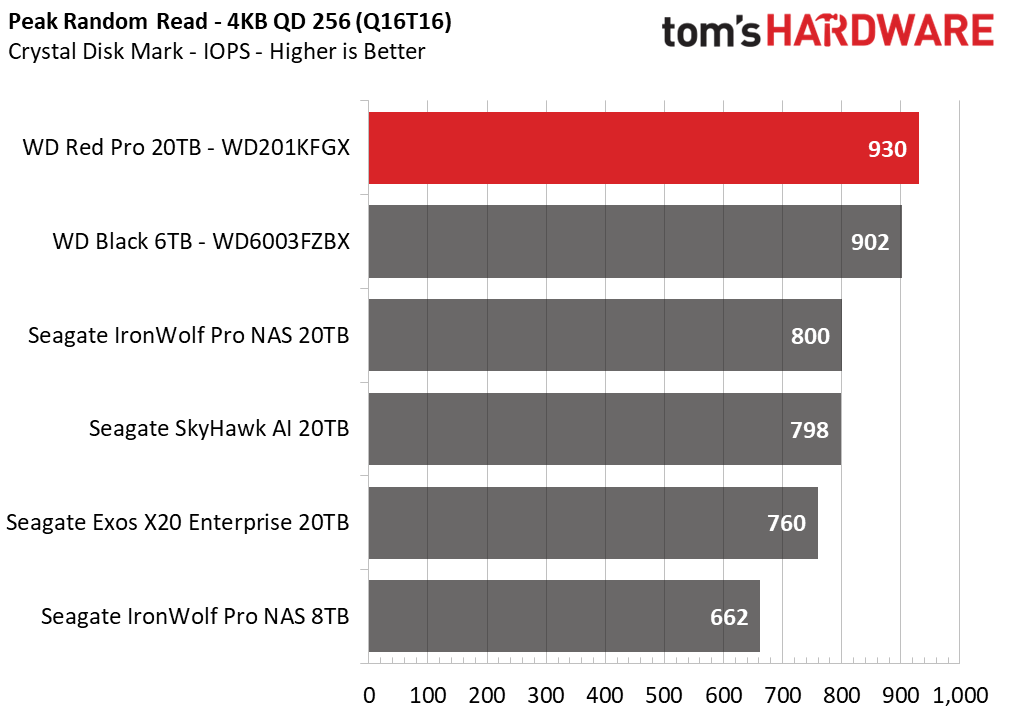
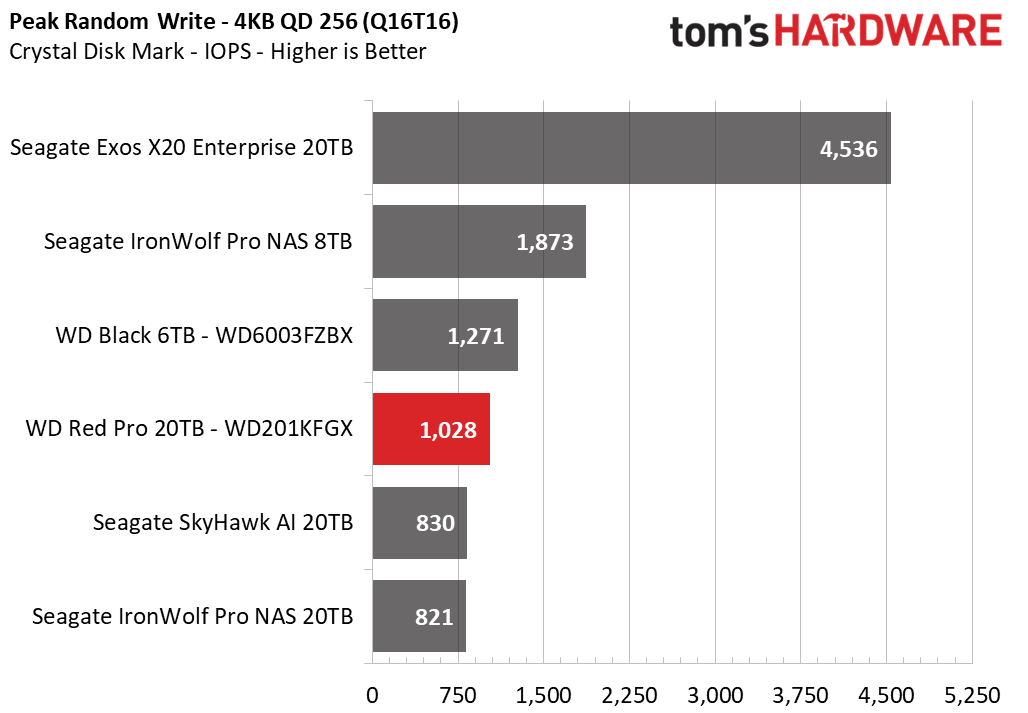
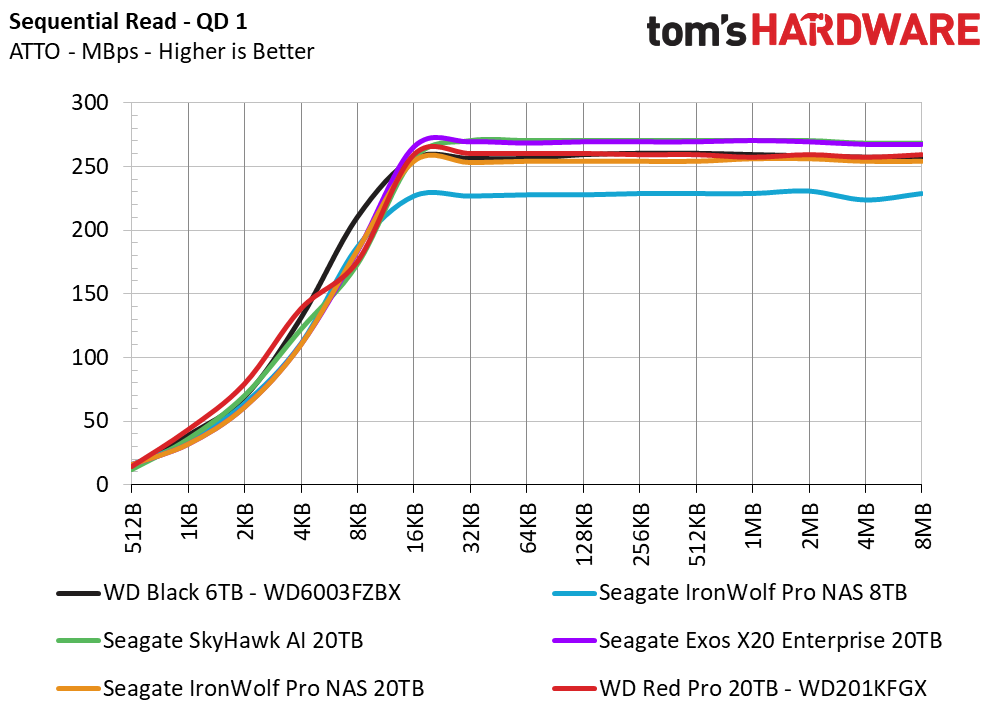
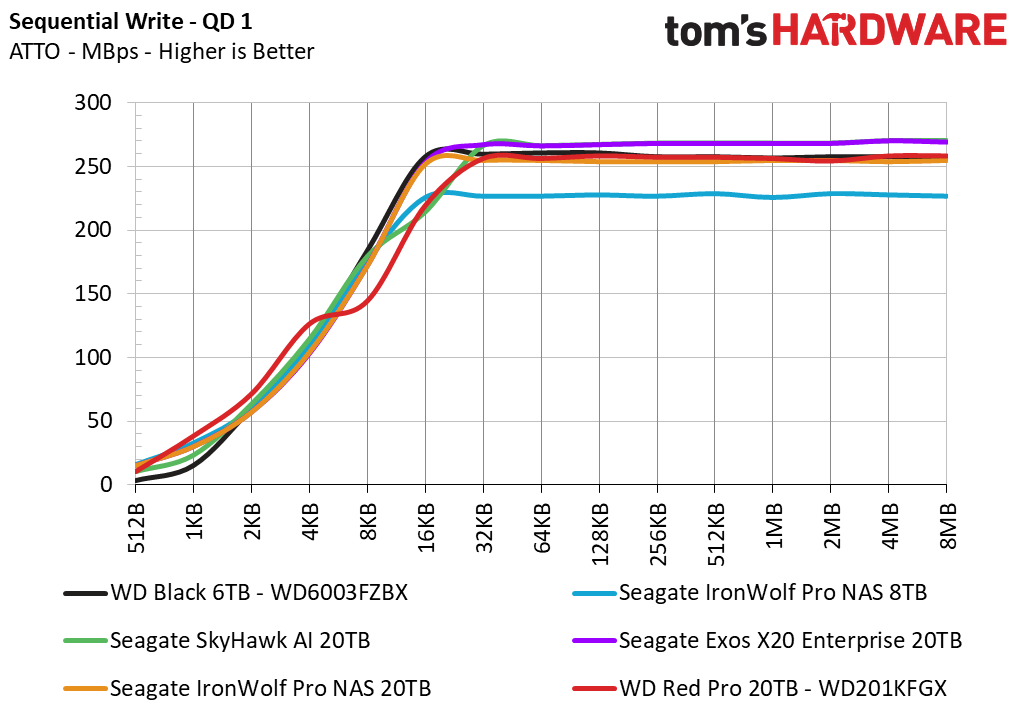
ATTO shows us something similar to DiskBench - very predictable, comparable results for sequential performance. HDDs get very close to their theoretical maximum transfer speeds in CrystalDiskMark, as well. 4KB performance is awful compared to SSDs, but the Red Pro stands out against its 20TB competitors. This may be due to the OptiNAND technology, which would also bring big latency benefits to larger I/O in certain write cache scenarios, although for now, that is only on the 22TB WD Gold.
Sustained Write Performance
Official write specifications are only part of the performance picture. Most HDDs implement a write cache which is a fast area of volatile memory such as DRAM. Sustained write speeds directly hit the platters and tend to be consistent. There are exceptions to both of these statements, as there are SSHDs (flash-containing hybrid HDDs), OptiNAND drives, and SMR drives that deviate from the traditional configuration. We use Iometer to detect the maximum sustained write speed of the HDD.
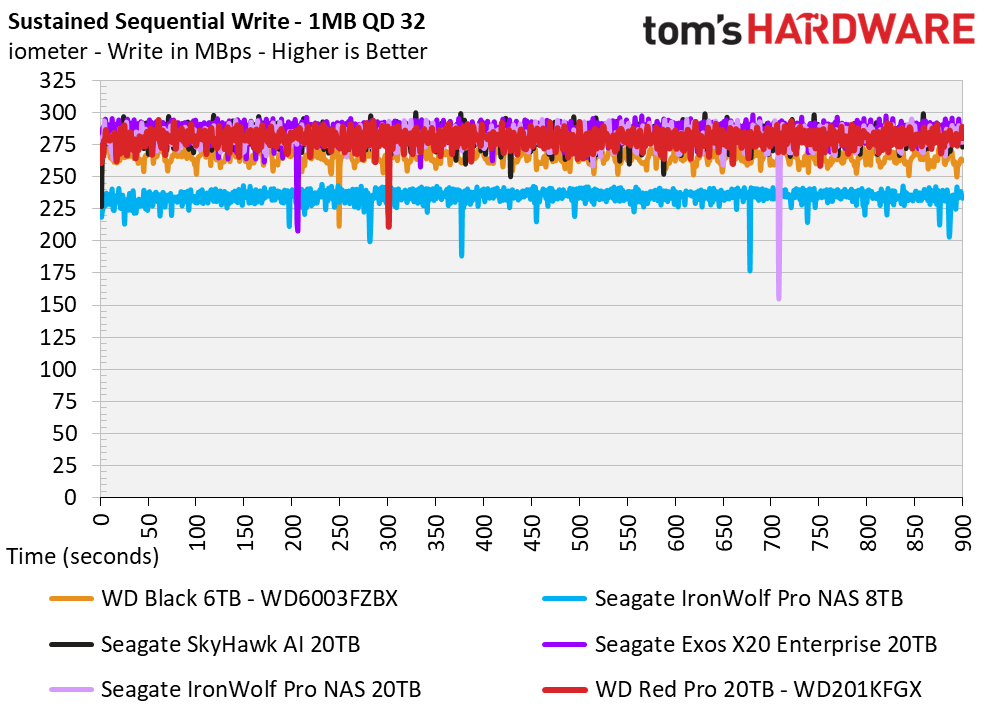
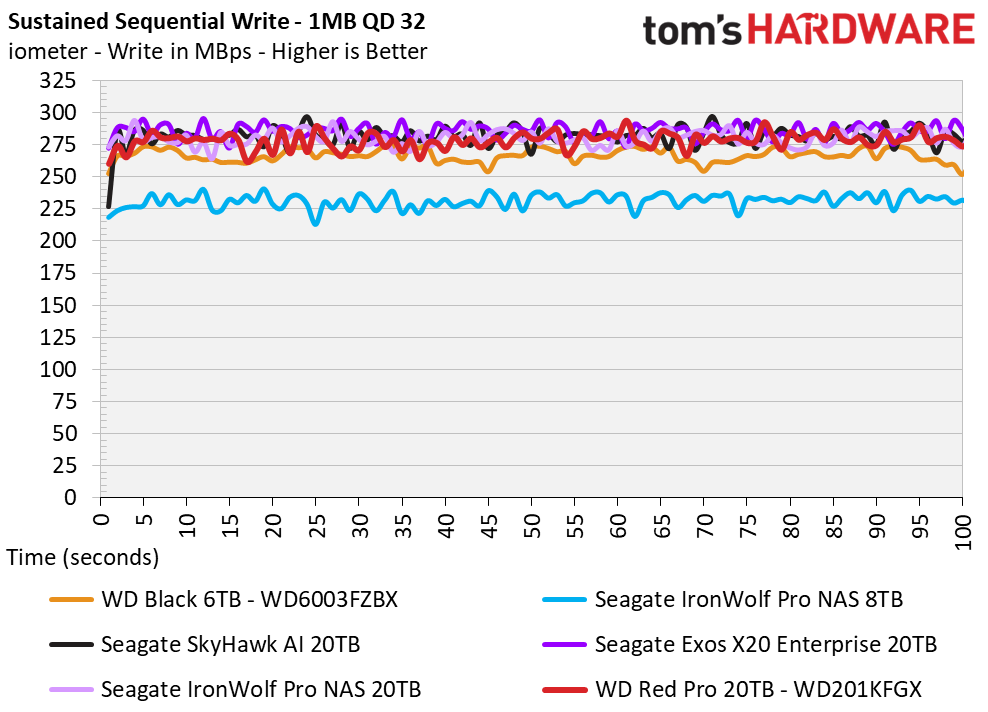

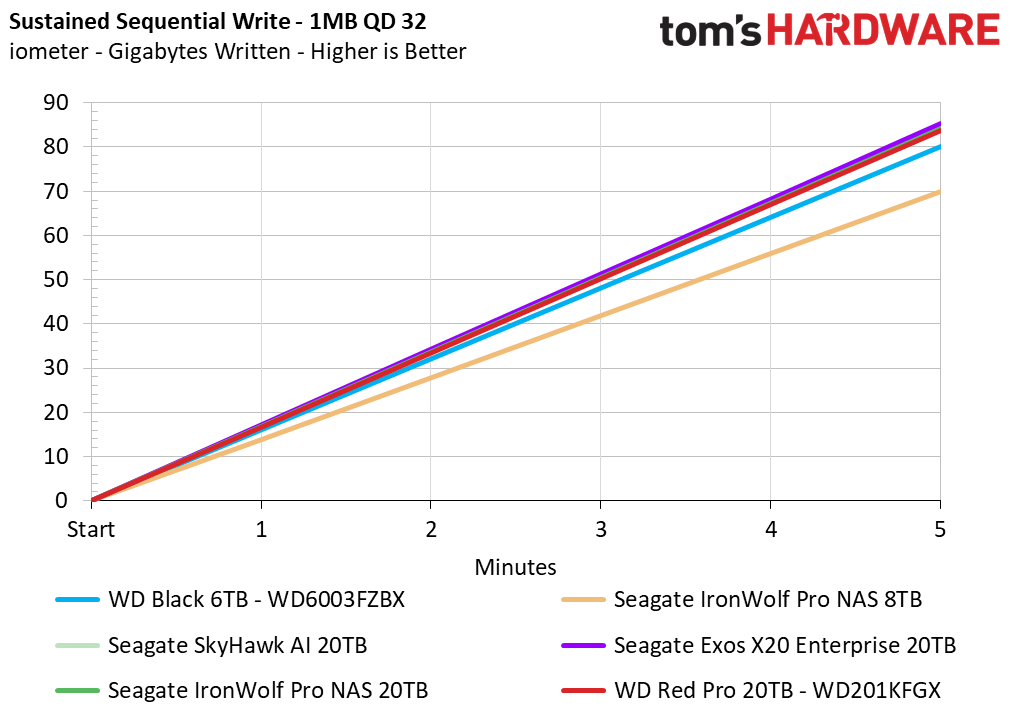

No surprises here, with very predictable sustained write performance. Certain technologies, like Seagate’s Mach.2, can almost double the sustained transfer rate, but with notable drawbacks.
Power Consumption
We use the Quarch HD Programmable Power Module to gain a deeper understanding of power characteristics. Idle power consumption is an important aspect to consider, especially if you're looking for a laptop upgrade as even the best ultrabooks can have mediocre storage.
Some drives can consume watts of power at idle while better-suited ones sip just milliwatts. Average workload power consumption and max consumption are two other aspects of power consumption, but performance-per-watt is more important. A drive might consume more power during any given workload, but accomplishing a task faster allows the drive to drop into an idle state more quickly, ultimately saving energy.
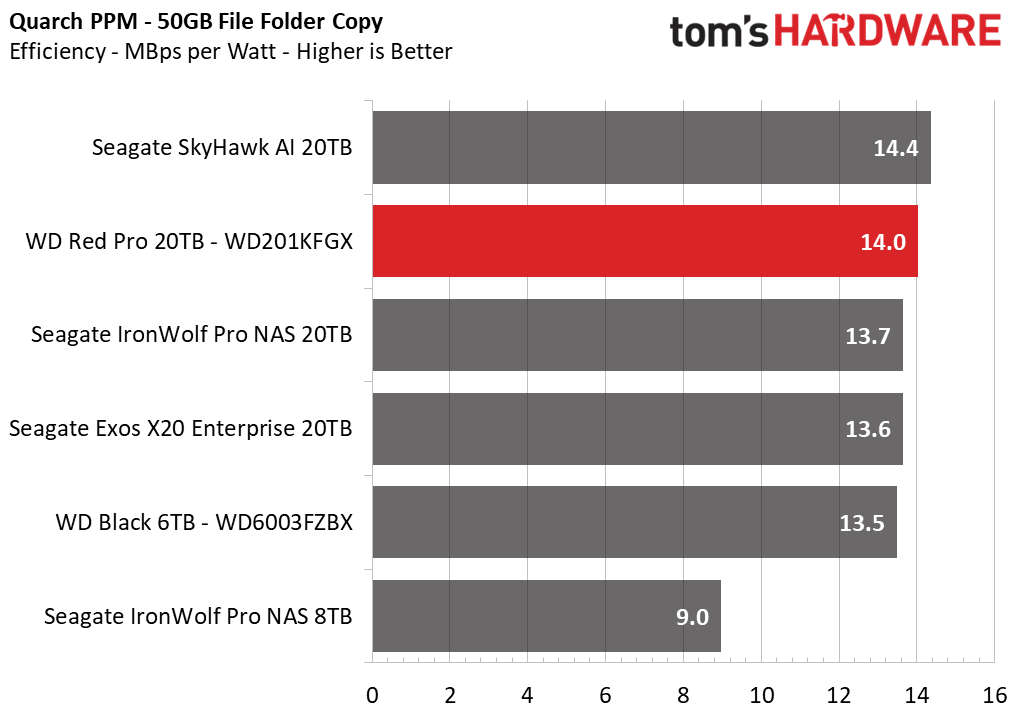
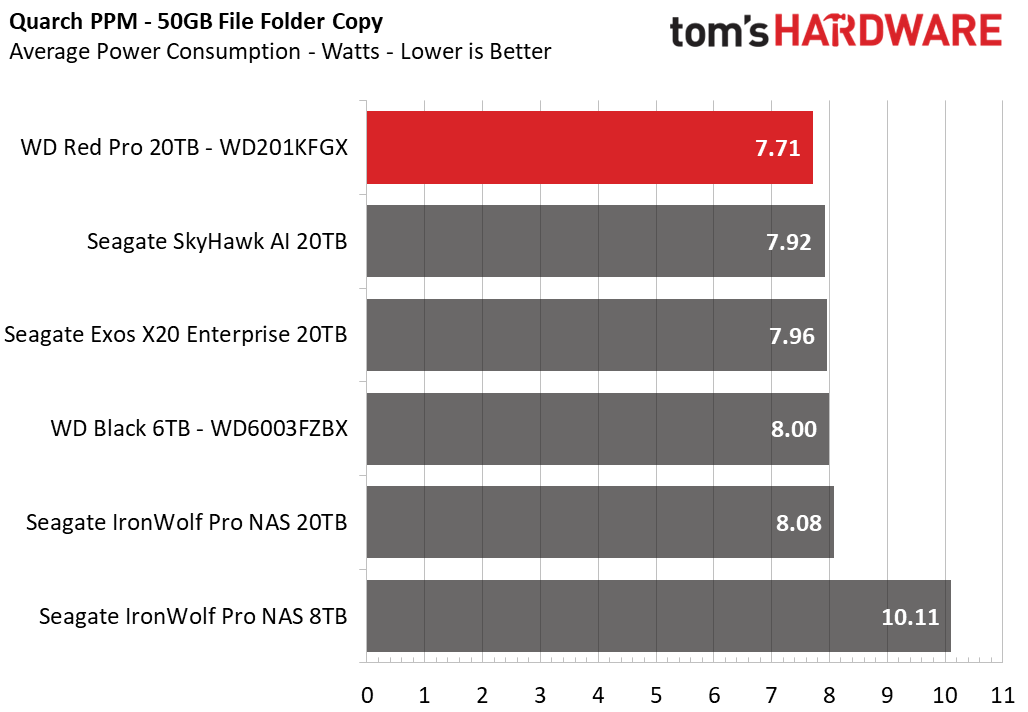
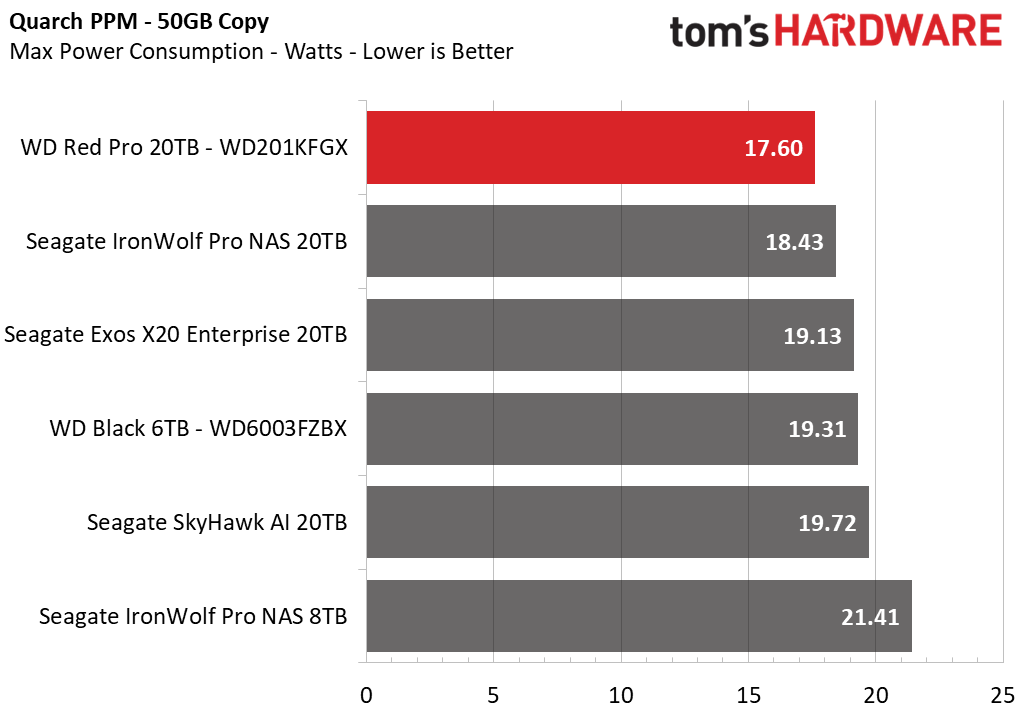
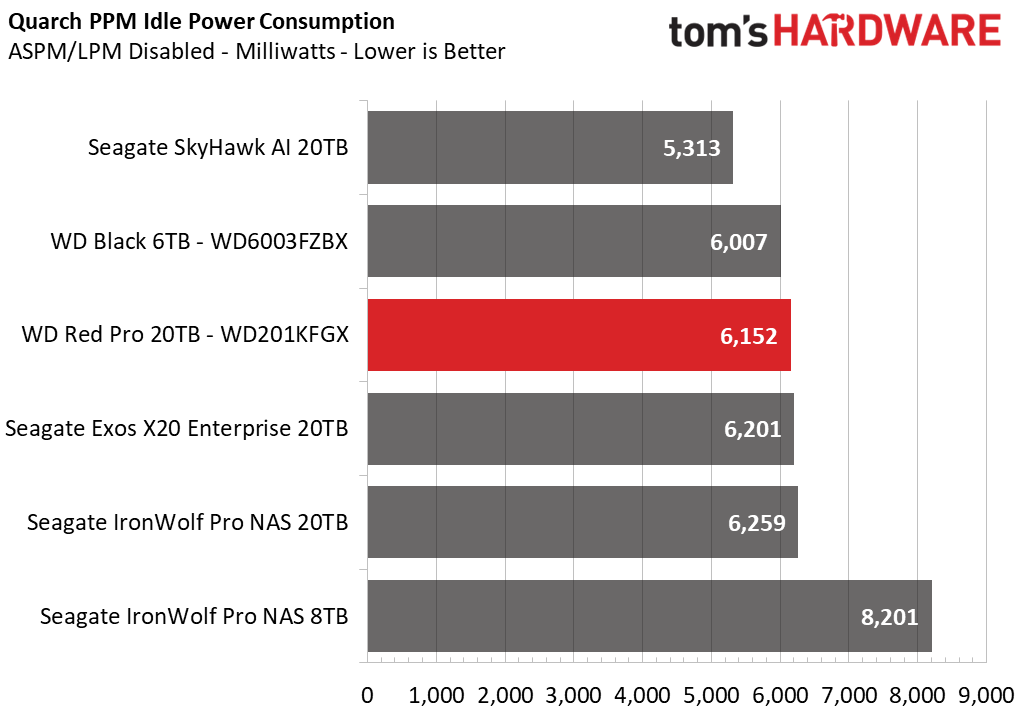
HDDs are power-hungry with all of the 20TB models pulling around 8W on average.
Test Bench and Testing Notes
Conclusion
The 20TB WD Red Pro performs as expected and checks the right boxes for a drive of this type. If you need a lot of storage for your NAS, it is a reasonable option. Pricing may vary, but you will generally pay a premium for this much storage, and the Red Pro’s price per TB is roughly comparable to the alternatives. Seagate’s Exos X20 and IronWolf Pro 20TB HDDs are direct competitors who perform very similarly for the intended workloads but may have better warranty and support options.
All of these drives use CMR technology without the drawbacks of SMR, but they arrive at these high capacities in different ways. WD’s unique approach uses NAND flash to offload metadata, which can improve performance and endurance and opens the door to other features. Right now, and for this drive, though, it should be treated as equivalent to the other options. Pricing is probably the biggest factor, although the IronWolf Pro’s Rescue Data Recovery Services may be enticing.
Beyond the bump in 4KB performance that the Red Pro displays, it also has the advantage of a larger DRAM cache. If the price is right, this may be the selling point to you that puts the drive ahead of the competition.
MORE: Best SSDs
MORE: Best External SSDs and Hard Drives
MORE: How We Test HDDs And SSDs
MORE: All SSD Content





